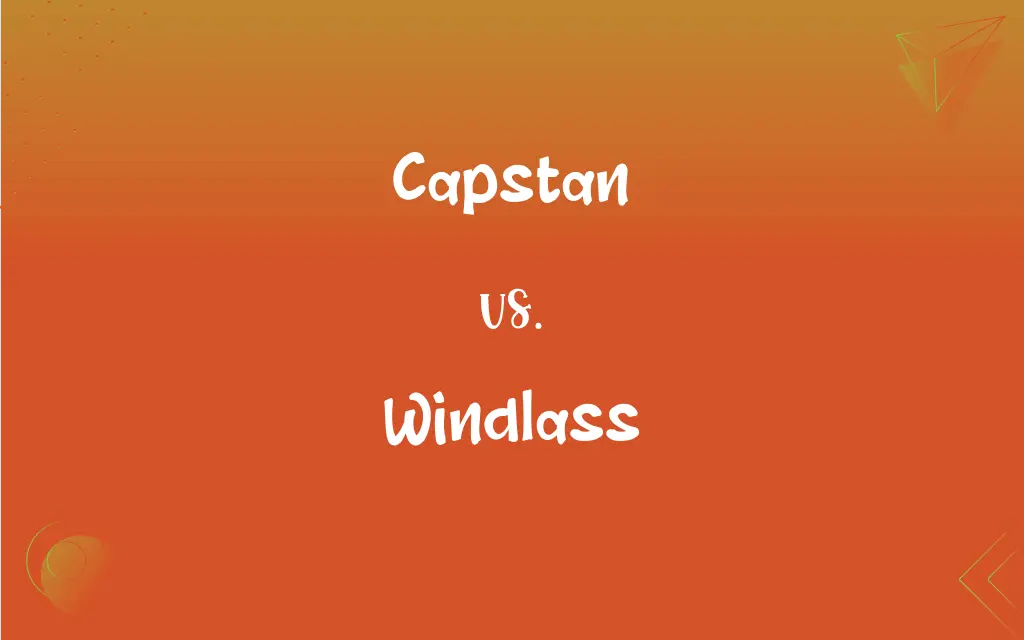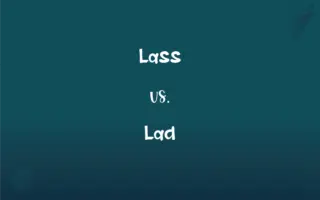Capstan vs. Windlass: What's the Difference?
Edited by Aimie Carlson || By Harlon Moss || Updated on November 6, 2023
A capstan is a vertical-axled rotating machine used on ships to apply force to ropes, cables, and hawsers, whereas a windlass is a horizontal-axled machine primarily used to hoist anchors.

Key Differences
Capstans and windlasses are both mechanical devices used on ships, but they differ in orientation and use. A capstan is a vertical spool used mainly to move heavy weights manually, and is often used to coil rope. Windlasses, in contrast, are horizontal and are commonly employed to lift anchors or to pull boats towards a pier.
The capstan, being vertical, allows for 360-degree access for the crew to push the bars and apply force, making it ideal for tasks like hauling ropes or nets. The windlass, with its horizontal drum, usually includes gears and may be operated by a motor, making it suitable for heavier tasks like raising an anchor.
Both capstans and windlasses make use of a drum around which a rope or chain is wound to increase mechanical advantage. However, the capstan's vertical drum is suited for pulling lines in any direction, while the windlass' horizontal drum is designed to pull primarily in a linear direction, which is ideal for the heavy, straight-line lifting of an anchor.
Historically, capstans were operated by human power, with several sailors pushing the capstan bars. Modern windlasses, on the other hand, are typically powered by hydraulics or electricity, reflecting the heavier work they are designed to perform.
In terms of installation, capstans are often found at multiple locations on a vessel, used for various tasks, whereas a windlass is typically mounted at the bow of a ship, dedicated to anchor handling operations. Both are critical for the functionality of a ship, each serving its specific purpose.
ADVERTISEMENT
Comparison Chart
Orientation
Vertical axle
Horizontal axle
Primary Use
Mooring, warping, and hauling tasks
Hoisting anchors and heavy lifting
Operation
Manual or motorized
Often motorized, especially on larger vessels
Positioning on Vessel
Can be located at various points
Usually located at the bow
Access for Operation
Allows 360-degree working space
Typically accessed from one side
ADVERTISEMENT
Capstan and Windlass Definitions
Capstan
A vertical rotating device used on ships for moving heavy weights.
The crew worked the capstan to hoist the sails.
Windlass
Essential for heavy lifting, found at the ship's bow.
The windlass must be robust to withstand the weight of the anchor.
Capstan
Utilized for tasks like mooring and controlling ropes.
We secured the ship to the dock using the capstan.
Windlass
Often motorized for efficient anchor management.
The captain activated the windlass, and the anchor began to ascend.
Capstan
Integral to marine operations, aiding in maneuvering ropes and cables.
The capstan made quick work of the heavy mooring lines.
Windlass
A key tool in the anchor handling system of most boats and ships.
Check the windlass regularly to ensure it's ready for use.
Capstan
Often manually operated by pushing bars around its base.
Sailors lined up to turn the capstan as they docked.
Windlass
A horizontal drum on ships, used mainly for raising anchors.
We engaged the windlass to lift the anchor off the seabed.
Capstan
Can be found on old sailing ships and modern vessels alike.
Even on modern ships, a capstan is indispensable for certain operations.
Windlass
Has a chain or rope wound around it for mechanical advantage.
By winding the rope around the windlass, we gained the leverage needed.
Capstan
(Nautical) An apparatus used for hoisting, consisting of a vertical, manually or mechanically rotated cylinder around which the cable to be pulled runs.
Windlass
Any of numerous hauling or lifting machines consisting essentially of a horizontal cylinder turned by a crank or a motor so that a line attached to the load is wound around the cylinder.
Capstan
A small cylindrical shaft used to drive magnetic tape at a constant speed in a tape recorder.
Windlass
To raise with a windlass.
FAQs
What is a windlass on a ship?
A windlass is a horizontal-axled device used primarily for hoisting anchors.
Can a capstan be used to lift anchors?
While possible, capstans are not typically designed for heavy anchor lifting like windlasses.
What is a capstan on a ship?
A capstan is a vertical-axled rotating device used for moving heavy weights like ropes and nets.
How does a capstan work?
A capstan works by rotating a drum around which ropes are wound, either manually or motorized.
Is a windlass used for mooring?
Windlasses are mainly used for anchor handling, not mooring.
Are windlasses manual or motorized?
Most modern windlasses are motorized for efficiency.
Do modern ships still use capstans?
Yes, modern ships use capstans for various tasks like mooring and warping.
What's the main advantage of a capstan?
The capstan's main advantage is its ability to apply force from any direction around its 360-degree access.
What's the main advantage of a windlass?
The windlass's main advantage is its mechanical design optimized for straight-line heavy lifting.
Are windlasses found on all types of ships?
Windlasses are common on ships that require anchor handling, not necessarily on all types.
How does a windlass work?
A windlass works by winding a rope or chain around a horizontal drum to lift heavy weights, typically powered by a motor.
Are capstans safe to operate?
Yes, when used correctly, capstans are safe, but they require proper training to operate.
What kind of maintenance does a windlass need?
Windlasses need regular maintenance checks, lubrication, and monitoring for electrical or hydraulic issues.
Can windlasses operate in any direction like capstans?
No, windlasses are designed for linear pulling, mainly in a forward or backward direction.
In what situations would you use a capstan over a windlass?
A capstan is used when you need to move or manage ropes and cables, especially in mooring operations.
What determines the size of a windlass on a ship?
The windlass size is based on the weight of the anchor and the size of the chain or rope used.
Are there any common issues with capstans?
Common issues include jamming, wear on the drum, and operational strain.
Are there any common issues with windlasses?
Windlasses may face issues like motor failure, chain jamming, and gear problems.
What kind of maintenance does a capstan need?
Capstans require regular lubrication and inspection for wear and tear.
What determines the size of a capstan on a ship?
The size of the capstan is determined by the vessel size and the weight of loads it will handle.
About Author
Written by
Harlon MossHarlon is a seasoned quality moderator and accomplished content writer for Difference Wiki. An alumnus of the prestigious University of California, he earned his degree in Computer Science. Leveraging his academic background, Harlon brings a meticulous and informed perspective to his work, ensuring content accuracy and excellence.
Edited by
Aimie CarlsonAimie Carlson, holding a master's degree in English literature, is a fervent English language enthusiast. She lends her writing talents to Difference Wiki, a prominent website that specializes in comparisons, offering readers insightful analyses that both captivate and inform.































































